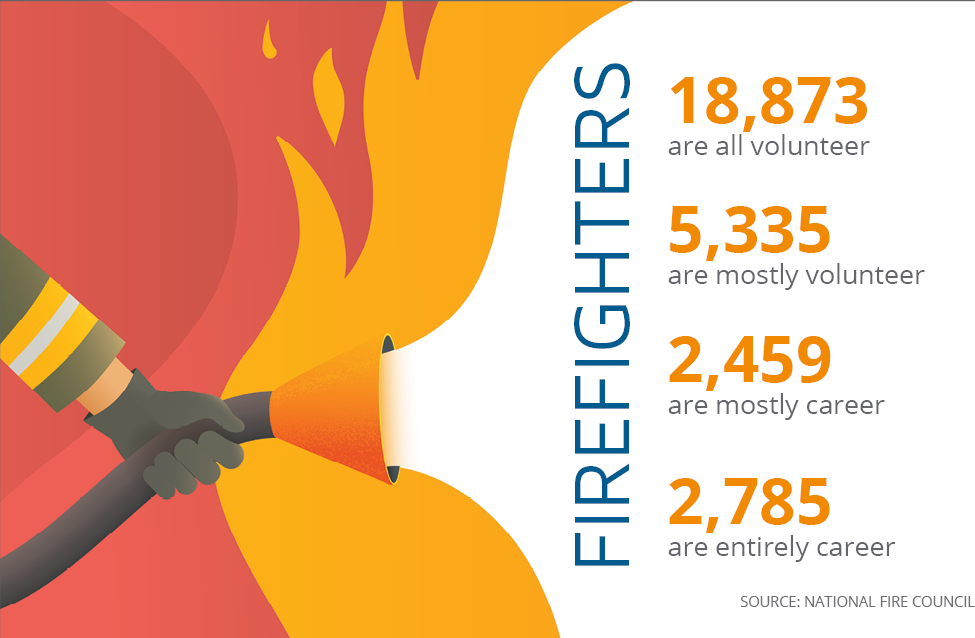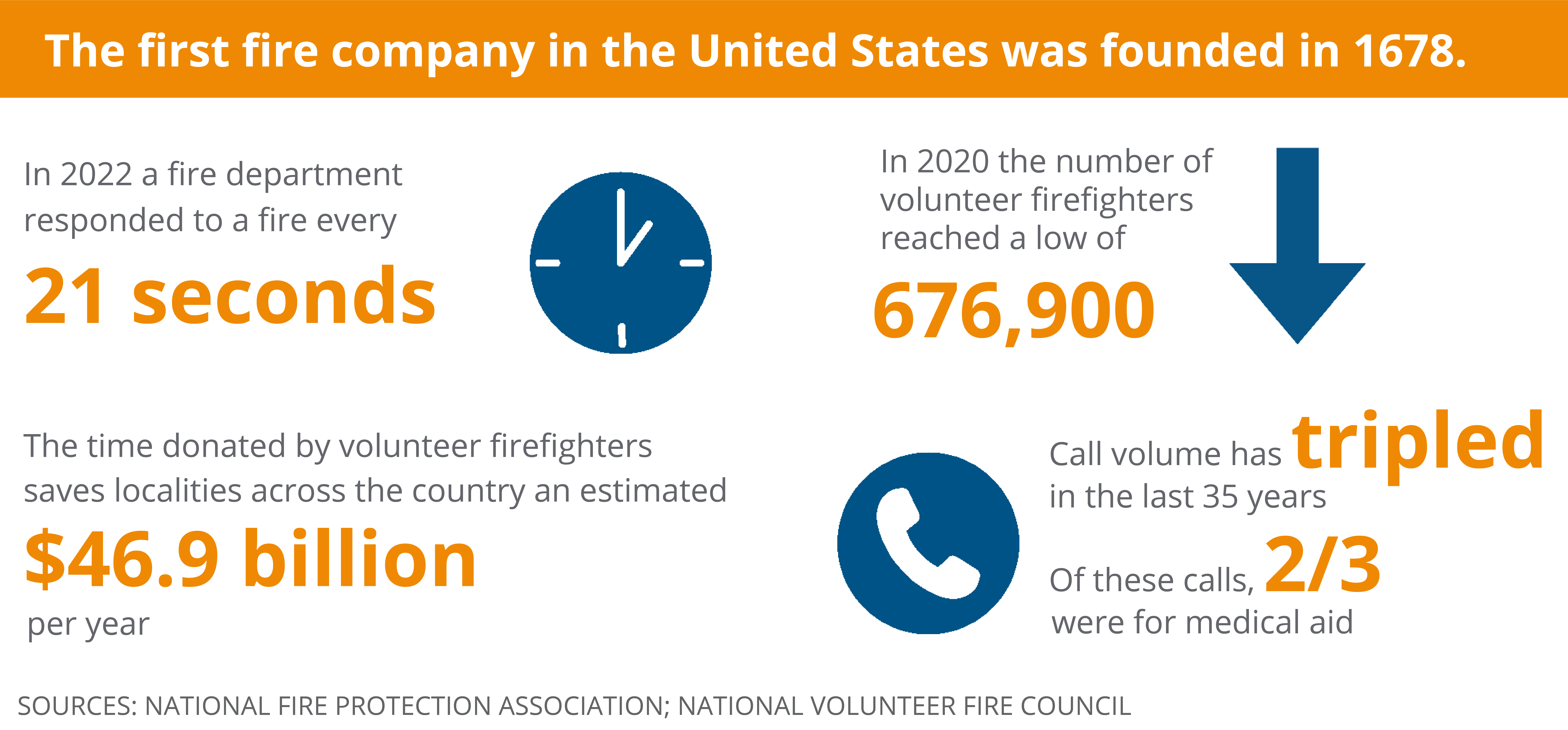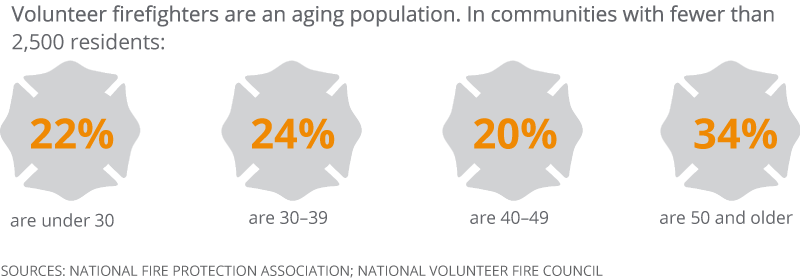Volunteer firefighters
By the time you finish reading this article, U.S. firefighters will have responded to another seven fire calls and 203 other types of emergency calls. It’s little wonder then that many Americans view firefighters as modern-day folk heroes. But most volunteer firefighters just see it as giving back to their communities.
“I have always wanted to join a fire department,” said Kelly Fosse, an underwriting manager. “I wanted to give back to the community and help others when they’ve found themselves in stressful situations.” She joined the Grinnell Fire Department as a volunteer firefighter in 2020, fulfilling a lifelong dream and an opportunity to pay it forward; paramedics had assisted her father in an emergency.
Chris Feldt, a firefighter with Northwest St. Clair County (Ill.) Fire Protection District, felt the call to serve, too. His great-grandfather died in the line of duty responding to a fire call. “I can remember my grandma telling me his story,” said Feldt, who is also manager for Heartland Mutual in Belleville, Ill. “After graduating high school in 1994, I decided it was something I needed to do. It was in my blood.”
Serving communities
It’s likely that the firefighters who respond to your next emergency call will be volunteers like Fosse and Feldt. More than 19,000 of the nearly 30,000 fire departments in the U.S. are volunteer-only operations, and of the 1.1 million firefighters in the U.S. in 2018, two out of every three were volunteers according to National Fire Protection Association (NFPA).

Not only do they provide critical services, volunteer firefighters also save their communities money. In its 2017 “Total Cost of Fire in the United States” report, the NFPA estimated it would cost $46.9 billion per year to replace volunteer firefighters with career firefighters.
However, “The most important and the most difficult-to-estimate value of volunteer firefighters is their availability in the community and their readiness to respond at any hour of the day without being compensated,” said the report authors.
This is especially true in small and mid-sized communities — 95 percent of volunteer firefighters serve departments that protect fewer than 25,000 people.
For example, Mark Suhr, president and partner at Suhr & Lichty Insurance Agency, is a third-generation volunteer firefighter with the Seward (Neb.) Volunteer Fire Department, which serves a community of 7,000. During the first 15 months of the pandemic, SVFD responded to 742 calls; Suhr participated in 380 of them.
“I have seen about everything, from birth to death,” said Suhr.

Wanting help
The number of volunteer firefighters has ebbed and flowed over the past 35 years, but the number of firefighters per thousand people has been declining, from its high of 8.05 per 1,000 in 1987 to just 6.06 per 1,000 in 2018.
I have always wanted to join a fire department. ...to give back to the community and help others. — Kelly Fosse, commercial underwriter
This decline doesn’t just affect firefighting. Not only do Americans depend on volunteer firefighters to assist with fires, they also count on them to serve as first responders for a wider variety of emergency services than ever before.
According to data from the National Volunteer Fire Council (NVFC), firefighters respond to calls for medical emergencies, car accidents, natural disasters, search and rescues, hazardous materials incidents, terrorism, and active- shooter events.
“Everyone in our department has things they are good at, and knowledge and experiences they bring to the table,” said Fosse. “I might not be the best person to carry a grown man out of a building. But being smaller in stature, I might be the best choice for a confined-space rescue.”
Declining numbers may be a problem nationwide, but it will require local solutions according to Jerry Zimmer, a 45-year volunteer firefighting veteran and former chief. He called recruiting the next generation of volunteers the most pressing problem for the Armington (Ill.) Community Fire Protection District.
“Finding people who are available in the daytime hours is difficult,” said Zimmer, who is also a producer at Midwestern Insurance Associates.

The challenges of balancing work, life, and volunteer firefighting led Chris Feldt to step down as captain of Northwest St. Clair County Fire Protection District, a position he had held since 1998.
“As a captain you are always on duty,” said Feldt. “I missed several of my kids’ baseball and softball games and school activities over the years since I was expected to attend all training activities and respond to calls when I was on duty.”
Training can also be a barrier. The average length of standard training modules to achieve Firefighter 1 certification, the base level of firefighter training, is more than 100 hours. People who seek this certification often complete it on nights and weekends over several months. And specialized areas — for emergency medical services or hazardous materials — require additional training time.
NVFC Chief of Communications Kimberly Quiros recommends that fire departments offer more flexible training options. “Incorporate training online with in-person and offer needed training at different times to accommodate different schedules.”
Fosse has found that word of mouth works best for the Grinnell Fire Department. “A lot of our firefighters have recruited their friends just by telling stories and showing how much they enjoy what they do.”
Pulling together
Volunteer firefighters bring out the best of the communities they serve: a spirit of camaraderie and the feeling of making a difference.
Steve Hirsch, NVFC chair and second-generation firefighter, recalls responding to a particularly difficult call — a fatal house fire — during the holidays in his Kansas community. His crew was told to wait for the state fire marshal to arrive for his investigation, which might have taken several hours.
“There was no way that our firefighters were going to make a family wait that long. The family had to have the peace of mind that their loved one had been found,” said Hirsch. “Our crew searched for that body — and then, once found, tenderly removed it from the scene.
“It was a reminder of how committed and compassionate these folks are. They were my firefighters, but firefighters all over the nation would have done the same thing.”
“The future of volunteer firefighting is very bright,” according to the NVFC’s Hirsch. “We have the best group of citizen-volunteers that you could imagine. They volunteer their time again and again to help out their neighbors in their time of need.”
“Volunteers have a calling to help their community and they are simply answering that calling,” said Quiros. “These are neighbors helping neighbors — regular people doing extraordinary things to help their community.
“Anyone who has the heart to serve can.”
Want to be a volunteer firefighter?
Visit makemeafirefighter.org to find out if your local department needs volunteers. You can also contact your fire station, department, or protection district and ask them how you can help.
Visit makemeafirefighter.org Learn how we're in the community